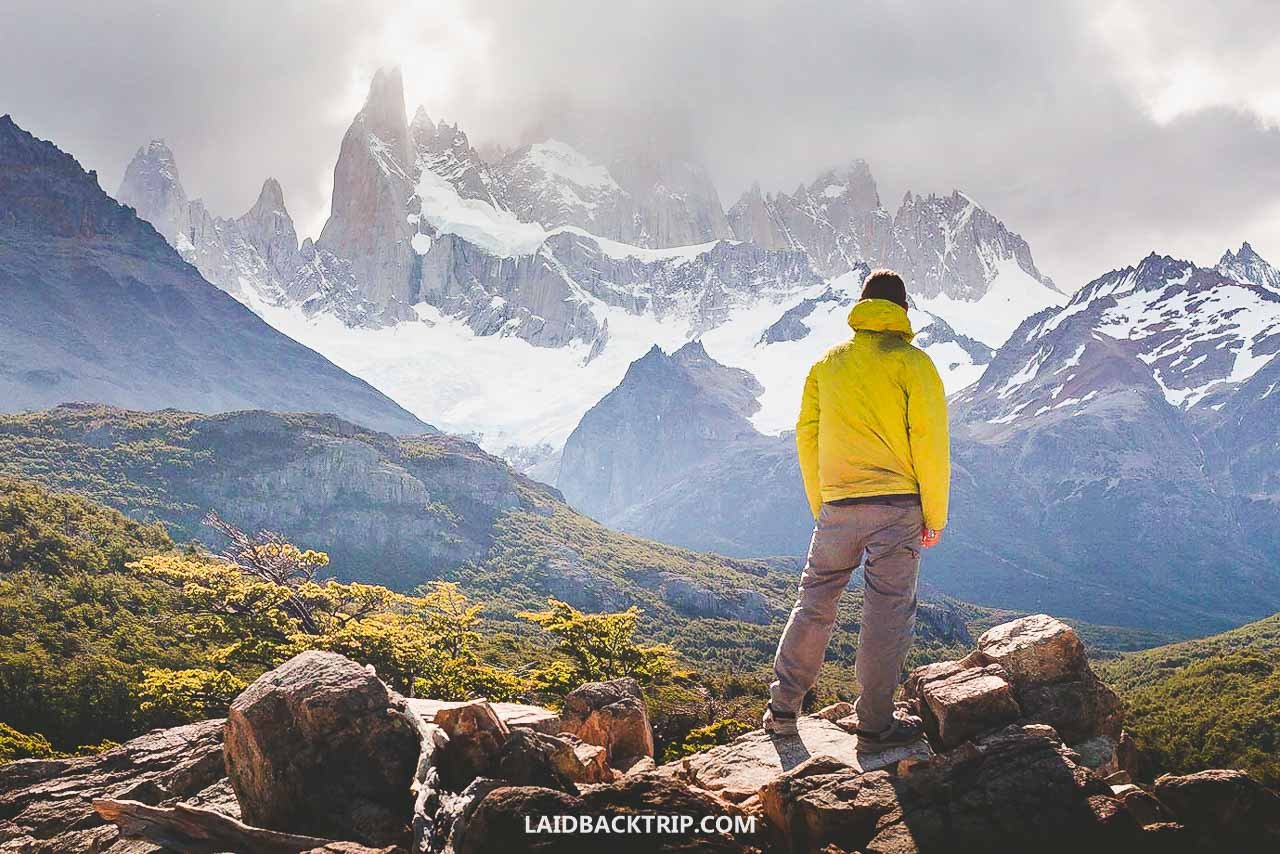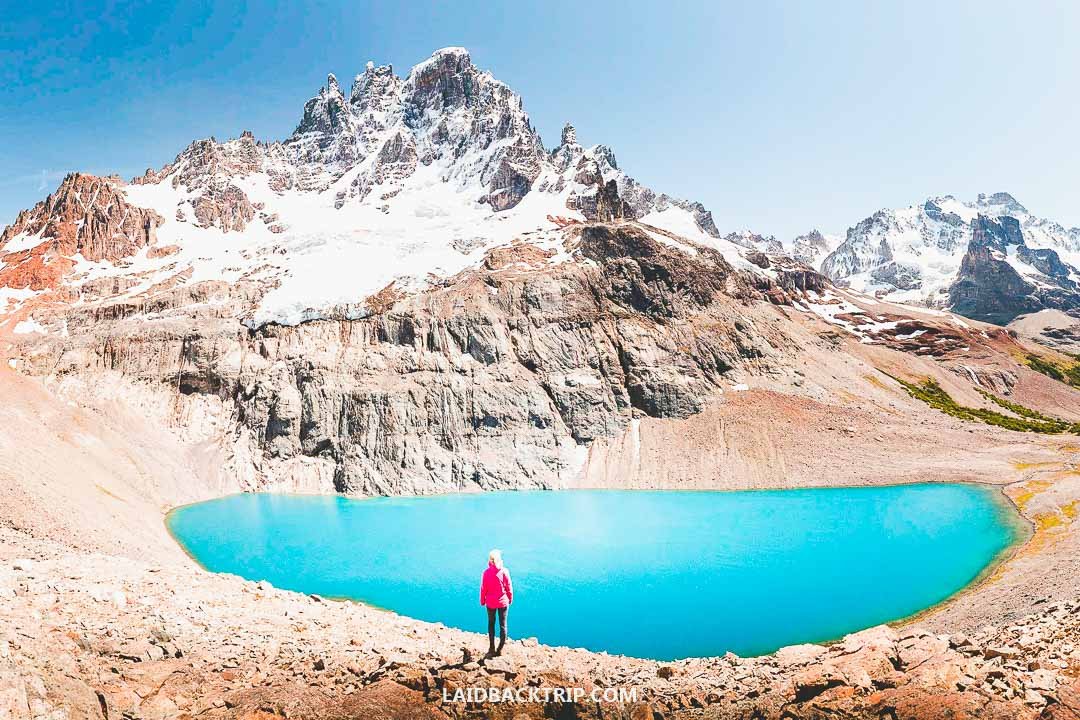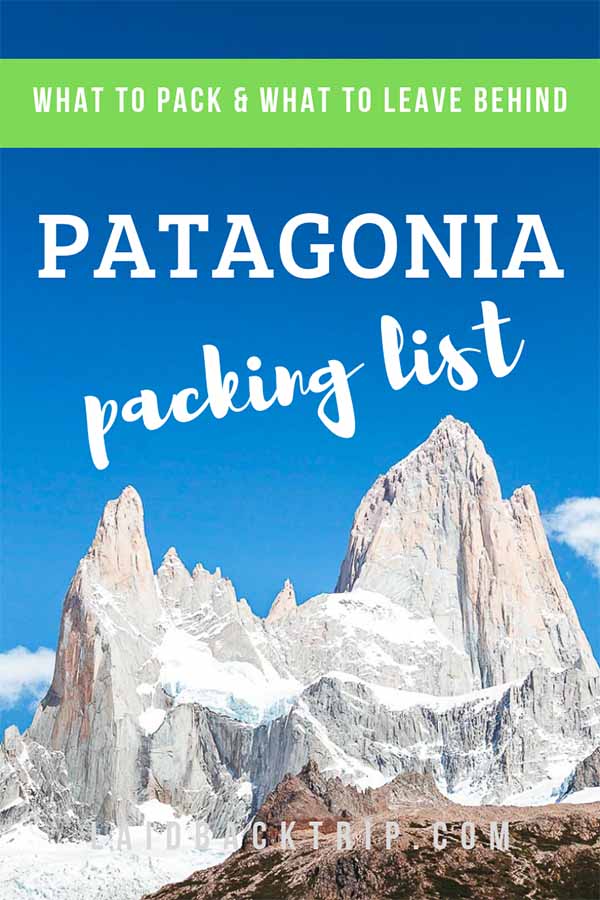Patagonia Hiking and Camping Packing List
Get prepared for your ultimate Patagonia hiking and camping trip. The weather in Patagonia is highly unpredictable, so it is essential to know what to pack to make your trip unforgettable. Read our Patagonia packing list guide on what you should pack and what to leave behind for your adventure activities.
Hiking in Patagonia had always been our dream, so when we were traveling in South America and Central America for a year, we made sure to include both Chilean and Argentinian Patagonia in our travels.
You can see the result here in this epic Patagonia itinerary.
Although for the big part of our one-year-long journey, we swore how heavy our backpacks were and how many layers of clothes we were carrying, eventually we found all our equipment useful in Patagonia.
It does not matter whether you plan to explore Patagonia in your car or prefer hitchhiking or travel by public transport.
It also does not matter if you choose to stay in warm lodges or camp for the majority of your trip.
Either way, we believe that you arrived in Patagonia to see the majestic mountains, lakes, and glaciers.
That's why you need to come well-prepared and well-equipped to make sure your Patagonia adventure will be unforgettable.
We've put together this ultimate packing list with only one goal in mind. To help you figure out what is essential to pack and what to leave behind.
This post is for every adventurous traveler who wants to explore the raw beauty of Carretera Austral, see epic Perito Moreno Glacier up close or hike in the world's top hiking destinations such as Torres del Paine and El Chalten.
After many years of traveling, we came to an important conclusion. It never pays off to buy cheap stuff when it comes to hiking and outdoor activities.
It is always better to invest in good quality equipment. Not only is the feel different, but the equipment then usually lasts much longer.
So if you are a total newbie looking for the best packing tips for Patagonia or a seasoned traveler looking for advice on how to make your camping and hiking trip into this unforgiving part of the world more comfortable, we've got you covered.
Weather in Patagonia
Although Patagonia has four distinct seasons, we are not afraid to say you will need to pack almost everything, no matter when you travel.
The reason is simple. Even warmer summer months can be very cold in the mountains, especially at night.
The best time for hiking is probably November to March, when days are warmer, but winds are strong, and it can rain from time to time.
It's also the best time to visit Patagonia in general.
Honestly, we've never experienced such strong winds as in Patagonia; sometimes, it was even hard to stand still or keep balance.
It is not a bad idea to visit Patagonia in the shoulder season in April or October when the weather can be pleasant, the wind is not that strong, prices are lower, and crowds fewer.
From late May to September, winter can be snowy and harsh, and we recommend exploring Patagonia during this time of the year only to experienced hikers.
Not only are there chances of avalanches, but hiking trails can be closed. Winds in winter cease, but temperatures drop.
Get Travel Insurance for Patagonia
When hiking in Patagonia, or overall in a more remote part of the world, it would have been very unwise to travel without travel insurance.
Given the remoteness and harsh weather conditions, accidents unfortunately happen.
We never leave home without travel insurance that was designed to cover our expenses if something goes wrong during the trip.
Travel insurance protects against theft, flight delays, injury, illness, cancellations, and much more.
World Nomads provides travel insurance for travelers to cover their trip essentials, including sports and adventure activities.
SafetyWing is affordable travel insurance for backpackers, long-term travelers, and digital nomads.
If you plan your travels in Patagonia, check it out as it is better to be safe than sorry.
What to Pack for Patagonia
When it comes to packing for Patagonia, we think the following items are essential when planning on spending your time actively.
Pack layers to make sure you will always stay warm, but do not overpack as it is not comfortable carrying a heavy backpack, no matter if you have a day trip or a multi-day trek on your itinerary.
Although we know some people enjoy admiring Patagonian peaks from a distance or through a car's window, we believe our readers are getting ready to hit the hiking trails, and that's why our packing list is aimed this way.
What to Pack for Hiking in Patagonia
Whether you plan on doing day hikes or multi-day treks, there are fundamental things you should pack for hiking in Patagonia.
You might already know what to pack in general for hiking or camping, but the chances are that you do not have an outdoor experience from such a difficult environment.
Here's what we recommend packing for both Patagonia's parts, Chilean and Argentinian.
Backpacks
Daypack 10-20L | We found out that a wrong backpack that doesn't fit your back can completely ruin the hiking experience. For a day hike in Patagonia, it is enough to have a maximum of 20 liters backpack where you can store your extra layers, snack, camera, and water.
Backpack 45-55L | For traveling between hiking destinations in Patagonia, you'll need a bigger backpack that will contain all your things.
Footwear
Hiking Boots | Trails in Patagonia can be rocky and muddy, and we would not recommend you to hike in anything else but quality, waterproof, and broken in hiking shoes with sturdy soles. Shoes with exactly this description are essential to enjoy the trails there.
Runners or Flip-flops | It is comfortable to take off hiking boots after all day walking, so bring whatever you feel comfortable in.
Jackets
Windbreaker | As we mentioned above, winds in Patagonia are extreme, and although waterproof jackets usually claim they are windproof as well, having a light windproof jacket was a live saver for us.
Rain Jacket | Weather in Patagonia can change literally within a second, and rain downpours are not uncommon during the summer hiking season. That's why having a waterproof jacket is a must.
Down Jacket | Even in the summer, Patagonia is a cold destination, and we use a down jacket on every single trek. Not when waking, but it was really cold when we sat down and wanted to take a break.
Fleece Jacket | Another must-have is a fleece jacket to stay warm. You will use it on both one-day or multi-day hikes.
Pants
Hiking Pants | We traveled Patagonia in summer, and although it was quite warm and we often wore shorts, hiking pants were necessary to have at least once a day, especially when we stopped hiking for a while.
Rain Pants | Ok, they don't look pretty but come handy as you can put them on quickly over your hiking pants when it starts raining out of nowhere.
Leggings | I always prefer hiking in leggings when I can, while Martin uses them only as a base layer when it is too cold.
Shorts | Afternoons were usually warm in Patagonia in the summer, even in the mountains. That's why we sometimes found shorts handy. However, this item is optional as all hikes were perfectly doable in long hiking trousers.
Base Layers
Short-Sleeved Functional T-shirt | When hiking, we started to sweat after a while, so we had to undress and carry on in only a short-sleeved t-shirt. We prefer functional t-shirts as they are light and dry quickly.
Long Sleeved T-shirt | We use long-sleeved t-shirts as another layer, usually under a fleece jacket.
Merino Functional Underwear | We always prefer functional underwear. It feels comfortable, and you won't be sweating that much.
Merino Hiking Socks | It is important to have good-quality hiking socks to keep your feet dry and prevent blisters.
Sports Bra | For girls, obviously. I prefer seamless sports bras underneath a t-shirt.
Hats and Gloves
Hat | Sun in Patagonia is strong, even when it is hidden behind the clouds, so always wear head protection.
Beanie | Pack a small and light beanie in case of strong cold winds. It won't take any space in your backpack.
Gloves | Gloves can come in handy, especially in the morning or evening, for sure when using hiking poles.
Gear
Water Bottle | Patagonia was the only place in South America where we drank tap water or water directly from the streams in the mountains. Reduce your plastic footprint and buy a reusable water bottle to fill it up along the way.
Sunglasses | As mentioned above, it is important to protect your eyesight from the strong sun.
Trekking Poles | Not sure if you have used hiking poles before, but we found them essential, especially when doing challenging treks almost every other day in Patagonia. If you have knee problems, hiking poles should be a no-brainer; when fit, hiking poles help you to keep pace.
Rain Poncho | When it rains a lot, we always prefer to wear rain poncho to cover not only ourselves but our backpack as well.
Toiletries to Pack for Day Hikes in Patagonia
When hiking, the most important thing, not only in Patagonia but anywhere in the world, is to pack as light as possible.
We had to learn over the years not to carry unnecessary stuff and take only the practical things. This also applies to toiletries.
It is way too easy to overpack on these items, but believe us; you can save a lot of grams on toiletries.
As we do not mind traveling frugally and think that natural appearance is just fine when exploring the mountains, we do not have a problem packing just essentials.
Sunscreen | It comes without saying that you should not even think to go outside without sunscreen on. We sunburnt multiple times in South America, so we had to learn the hard way.
Insect Repellent | There were places in Patagonia with not a single mosquito around, while, for example, when hiking to Laguna Cerro Castillo, we couldn't get rid of them. Either way, we would pack a small mosquito spray.
Lip Balm | You've probably noticed we don't take sun protection lightly; this is another must-have, not only against the sun but also against the wind.
Electronics
Another gear that usually weighs quite a lot is electronics.
We believe that every packing list nowadays includes at least a camera, but it is good to know that a camera usually comes with a charger or power bank.
This is why many travelers like to keep it simple and often travel only with a mobile phone. We are absolutely fine with that.
Many phones have great cameras, so the outcome is quite quality, and it is only up to you if there's something you cannot live without.
Just remember you always have to carry it.
Mirrorless Camera | Although some memories last forever, we like to remind ourselves of the places we traveled. As we've already mentioned, some people use only a mobile phone to take pictures, but we think the mountains in Patagonia deserve a nice camera.
Memory Cards | It is possible we take more photos than the average population, but you should still carry a spare memory card or two in case you won't have a chance to transfer your photos every day.
Travel Adapter | We solved the problem of different electrical plugs and sockets by buying a multi-plug adapter, so we don't have to think about charging our stuff no matter where we go.
Chargers and Batteries | Do not forget to pack chargers for all your devices.
GPS Watch | Smartwatch has been very trendy lately, and you can find it useful for outdoor activities.
Camping Gear
Patagonia boasts many multi-day treks, and if you have time, this is for sure one of the best ways how to explore this sought-after destination.
Are you planning on camping in Patagonia? You should pack the following items on top of the packing list above.
Backpack
Deuter Backpack | When you plan on hiking multi-day treks such as O or W in Torres del Paine, you need to have a backpack which can fit a sleeping bag (because of the high chance of rain, it is not a good idea to keep it outside just hanging on your rucksack), and other camping equipment.
Also, when traveling long-term, you will need a large backpack anyway.
Sleeping
Lightweight 2-Pax Tent | Conditions in Patagonia can be harsh, so make sure to pack a windproof and waterproof tent, but do not forget you will be carrying it for days, therefore choose the light one.
Sleeping Bag | The same goes with sleeping bags. We prefer down sleeping bags as they are lighter and are easily foldable; the only downside is the initial cost.
Sleeping Mat | The cold at night usually comes from the ground - an air mattress should protect you the best, plus it is small and light.
Silk Liner | We never travel anywhere without the cocoon. We often use it in hostels where we are not sure about the cleanliness, but here in Patagonia, you can use it as an extra layer for your sleeping bag.
Thermal Underwear | We don't want to freak you out, but it can get very cold in Patagonia at night. Thermal underwear is a great solution for how to feel comfortable.
Cooking
Cooking Set | To have enough energy, buy a cooking set so you can prepare proper food during and after every hike.
Ultralight Cooking Stove and Stove Fuel | For security reasons, bring your own stove but buy gas cans on the spot. You can find gas cans even in small, not specialized stores.
Stove Screen | Without a shelter around, it would have been impossible to cook in the Patagonian mountains because of strong winds. Make sure to pack the stove screen.
Dried Food | We tried dehydrated food for the first time in Canada and liked it. It is a bit more expensive, but it is light, and the food is ready really quickly.
Gear
Foldable Knife | You just cannot go camping without a foldable knife.
Padlock | When camping, it is hard to keep your stuff safe. You can take a padlock to lock your backpack or tent, but it is not 100% safe. That's being said; we think Patagonia is one of the safest places where you can be in South America.
Headlamp | Sun goes down pretty early in Patagonia, and you will need headtorch no matter if staying in a tent or a basic lodge along the trail.
Dry Sack | Because of the unpredictable weather, bring along dry bags to protect your valuables.
Electronics
Kindle | If you like reading and cannot imagine your holiday without a book, a portable library is a real treat.
Power Bank | It depends on how long you plan on camping, but the power bank is a great thing that ensures your electronic devices will keep working for many days.
Toiletries
Deodorant | This one really works.
Bamboo Toothbrush and Toothpaste | Although we know you won't forget these two items, check out our suggestions if you want to travel more sustainably.
Soap and Shampoo | When in nature, we suggest using biodegradable soap and shampoo.
Wet Wipes | We prefer water over wet wipes, even if it's freezing cold. But some people like them.
Hand Sanitizer | Both of us use contact lenses, so we always bring hand sanitizer, but it is useful every time when the water source is not around.
Travel Towel | Even when no shower is around, you can wash a bit in streams, and a travel towel will come in handy.
Medical Kit | Always make sure you have personal medicaments you use on a daily basis with you, plus a few stuff like pills for a headache or diarrhea.
Travel Resources
Here you can find links to all the travel resources we use and which you might find helpful when planning your next holiday.
Accommodation: When looking for accommodation, we usually search hotels via Booking.com or Hostelworld.
Tours: Although we love to travel independently, some places are better to visit with a guided tour.
We prefer GetYourGuide for its easy-to-use interface and solid reputation. Another great alternative is Viator.
Rental Cars: When going on a road trip, we always use Rentalcars.com, a reliable site for booking a rental car in advance.
Flight Tickets: When looking for flight tickets, you can search Skyscanner to find the best price.
Travel Insurance: World Nomads and SafetyWing cover against risks of travel.
Some of the links on this post are affiliate links. If you choose to purchase using these links, we receive a small commission at no extra cost to you.












